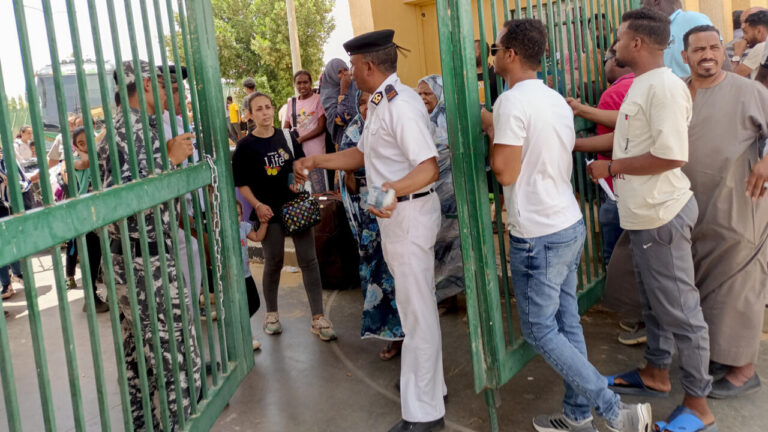Hundreds of thousands of people have fled Sudan in the past two weeks, according to UN High Commissioner for Human Rights. But thousands remain imprisoned in the country.
Violent battle between the army leader’s forces Abdel Fattah al-Burhan and his former number two, Mohamed Hamdan Daglo, who heads the paramilitary RSF, have rocked the country since April 15. Deadly clashes have caused a mass displacement of civilians, the scale of which still difficult to determine.
Tens of thousands of people from the western region of Darfur, which is volatile, have cross the border in Chad. Others are trying to reach South Sudan, the Central African Republic, Egypt or Ethiopia, raising fears of mass migration from a country with 45 million inhabitants, one of the largest in Africa.
There is no stopping
Despite the latest three-day ceasefire set to expire at midnight, army forces clashed with paramilitaries on Sunday in the Sudanese capital Khartoum. Fighting was reported around the army headquarters in the center of the city, with the Sudanese army also carrying out air strikes in the capital’s twin city of Omdurman across the Nile River.
Although countries such as Saudi Arabia, France and the United States have been able to repatriate citizens and diplomats in recent days, millions of civilians living in Khartoum are caught up in the chaos that grips the metropolis. Without outside help, they face a dilemma: risk their lives on the road or remain confined to their homes, where they endure crippling water and electricity shortages.
“To leave the city, you have to avoid bombing raids. The roads are no longer safe and armed attacks happen frequently. Travel costs also quadruple and there is a shortage of gas,” he explained. by Omar*, a Sudanese journalist whose family escaped Khartoum on April 26.
“In the east of the country where I live, things are still calm. Some people come here to seek refuge in big cities like Kassala, Al-Qadarif and Port Sudan. Others go to Ethiopia in east or Egypt to the north so that the country may flee.”
More than 14,000 Sudanese people and an additional 2,000 citizens from other countries have crossed into Egypt since the conflict began, according to government of the country.
Meanwhile, International Organization for Migration (IOM) spokesman Eric Mazago told AFP on Thursday that more than 3,500 people migrated southeast to Ethiopia between April 21 and 25.
A ‘race against the clock’ in Chad
Another hot spot in the conflict in Sudan is the western region of Darfur, which is still engulfed in a war that exploded in 2003. Its capital, El Geneina, has seen an increase in attacks on civilians in recent days.
At least 20,000 people crossed into Chad in the first 10 days of the conflict, according to UNHCR, despite its government closing the border with Sudan at the start of the conflict on April 15.
The country already hosts more than 400,000 Sudanese refugees in 13 camps in local communities, who fled the 2003 to 2010 genocide.
Border villages with Chad such as Koufron, Midjiguilta and Dize Birte have seen the highest influx of displaced people. Humanitarian organizations on the ground are working to provide emergency assistance by providing water, food, health care and temporary shelter.
We are in “a race against the clock” says UNHCR deputy representative in Chad Jérôme Merlin, calling on the international community to help. “Within two months, maybe less, the monsoon will create large rivers or ‘wadis’, which will make it difficult to provide aid.”
The ‘premature’ is back in South Sudan
As more and more people seek sanctuary in neighboring countries, South Sudan is also seeing an influx of civilians who feel the violence. At least 14,000 people have crossed the border, UNHCR spokeswoman Shabia Mantoo told AFP on Saturday.
“These people come from different places in Sudan. They travel by bus or by their own means of transport,” explained Faith Kasina, a UNHCR representative based in Nairobi who coordinates in humanitarian response. “They decided to return to their home country because they have family there, although most left for security reasons,” he said.
Since 2013, South Sudan has been caught in a civil war between the government of President Salva Kiir and a rebellion led by former vice president Riek Machar.
In a statement released on April 26, UNCHR head Filippo Grandi expressed his concern that South Sudanese refugees “have been forced to return home prematurely in deep uncertainty”.
“Only a few kilometers away”
As Sudan enters its third week locked in deadly conflict, a long-running power struggle between the country’s army and the RSF paramilitary group continues. Rival forces accuse each other of violating the latest ceasefiremediated by the United States, Saudi Arabia, the African Union and the United Nations on Thursday.
“There are two unique situations taking place in Khartoum and El Geneina in Darfur that prevent Sudanese from fleeing,” said Claire Nicolet, who heads Sudan operations for Doctors Without Borders. “It is very difficult to leave Khartoum, but once outside, the situation becomes easier. However, in Darfur’s capital El Geneina, the roads around the city are dangerous. It takes about an hour to reach the Sudan border from to El Geneina, but for now it is an impossible journey to make.”
The UNHCR team stationed at the border with Chad made similar observations, and expected a larger influx of refugees to come.
“The majority of Sudanese who have arrived in Chad so far have come from villages close to the border, just a few kilometers away,” said UNHCR representative Merlin. If there is a lull in the battle, “we expect a bigger wave of those to come” , he explains.
Faced with a bloody labor crisis, the African Union on Thursday called on Sudan’s neighbors and international partners to “facilitate the transit” of civilians fleeing the violence “without hindrance”.
*Name changed upon request
This article was translated from original in French.
